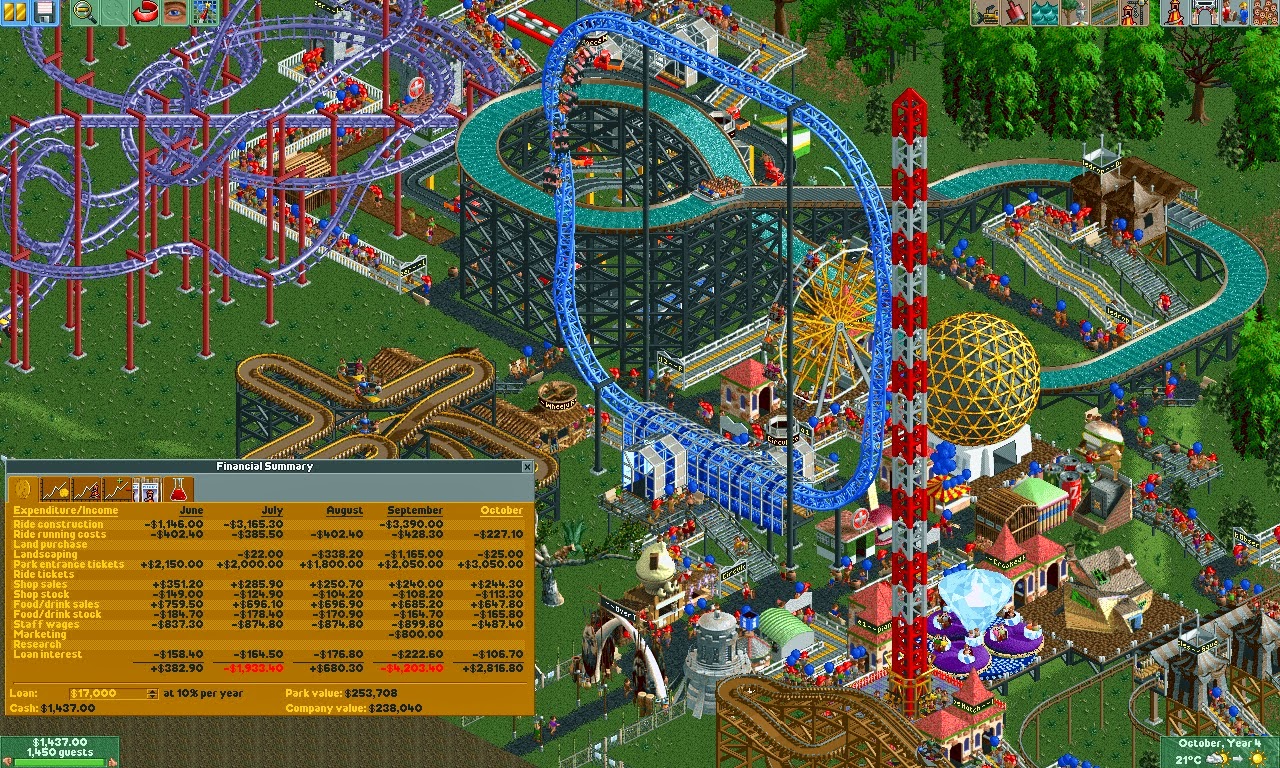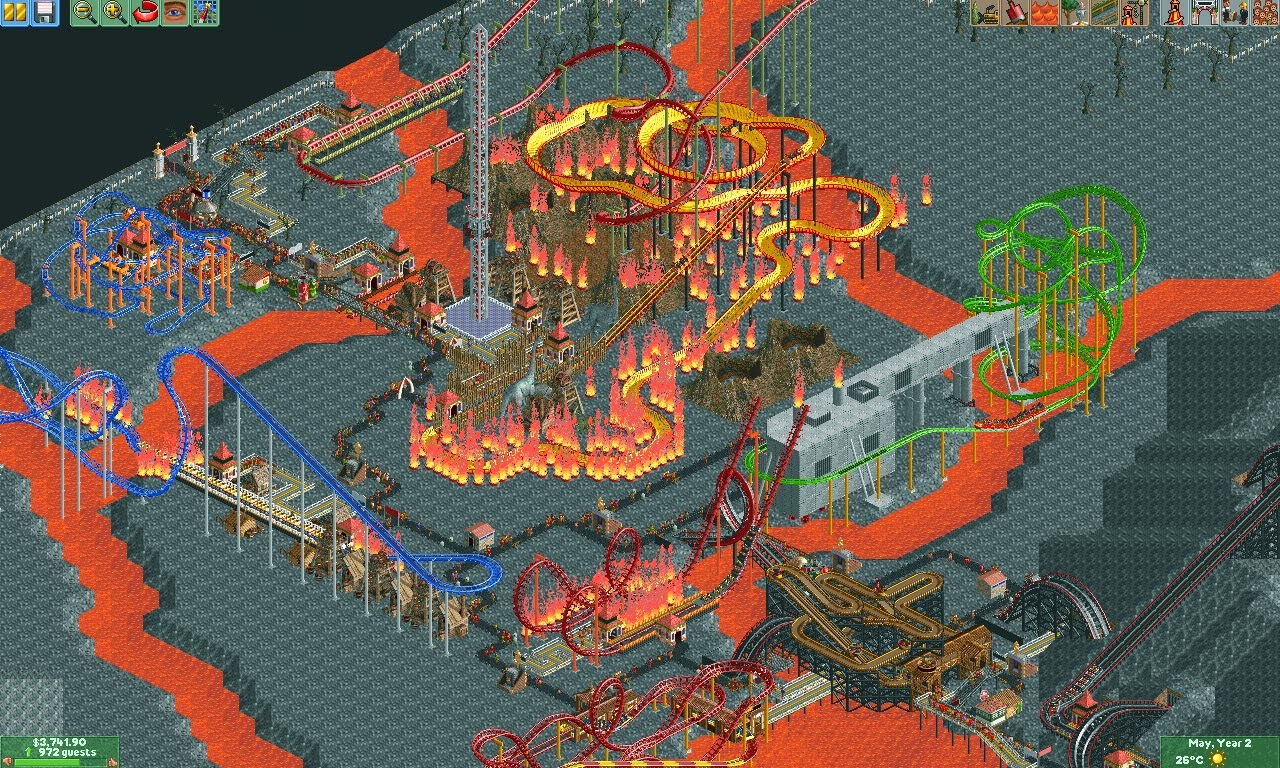RollerCoaster Tycoon 2
Developer: Chris Sawyer Productions
Released: October 2002
Played: about half of the scenarios complete in 25h
About
Ever wanted to build your own theme park? Build roller coasters, rides, and attractions in crazy settings across the world, including canyons, mountains, deserts, and volcanoes. Manage your profits, expenses, and guests in a variety of scenarios to meet success before your deadline.
At Launch
RCT2 received positive reviews, averaging around 75%. The game was heavily criticized for being so similar to the first game as a standalone release, and the camera was cited as the biggest flaw. But everything critics loved about the first game is still present, and despite the similarities, reviewers did point out the many improvements.
Post Launch
Two expansion packs were released, each adding new scenarios and decor themes. Wacky Worlds includes aesthetics from various major cultures around the world, while Time Twister adds science fictional elements.
The Triple Thrill pack includes the base game and both expansions.
_____________________________________________________________________________
I got the original RollerCoaster Tycoon in a cereal box a very long time ago and loved it, but I never played the sequel... until now. I wasn't really sure what to expect since I never really read anything about RCT2.
The first thing that struck me was how much more complex the game was than I had remembered. Well, no, the actual first thing I noticed was that the graphics and music and interface hadn't changed at all, but I'll come back to that. Anyway: RollerCoaster Tycoon is a game that seems simple at first - build some rides, make some money, build some more rides, etc. But there's actually quite a lot going on.
When you build a roller coaster, you have three main variables to take into account: Excitement (how much fun the ride is), Intensity (how physically taxing and intimidating the ride is), and Nausea (how much the ride makes people want to throw up). Excitement is influenced by the ride's features and surroundings: a coaster that runs through a building and through the loops of another coaster is more exciting than a standalone in an empty field. Intensity is determined primarily by the G-forces affecting the riders. And nausea is mostly induced by repetitive motion, such as many consecutive loops or a long spiral. You also have to deal with your budget, the price you charge for a ride, the operating costs of the ride, how long guests spend in line, and plenty of other metrics.
And this is just for a single coaster. With the park as a whole you have to deal with path and ride maintenance, pedestrian flow, customer satisfaction, loan and staff payments, advertising, changing demand based on weather conditions and ride age, placing attractions to maximize profit and efficiency...
I'm sure that such a big complex list sounds like a nightmare to deal with, but in practice it's not too difficult. The interface makes it very easy to find information at a glance. You can view a financial summary of your park to see where your money is going and help decide if you're spending too much on staff. Each ride and vending booth provides stats on its operation, finances, and customer satisfaction to help you choose what to charge and whether to keep it open. You can even see what your guests are doing and thinking - if a lot of people are hungry you should add more food stalls, and if people are complaining about dirty paths you may need more handymen.
All of this information is easy to find and makes it pretty clear what you need to do to improve your park, but that doesn't mean the game plays itself. You have to stay alert and watch for problems as you improve your park, because while you can easily pull up stats, not everything is obvious immediately. If you build a park that's too complex it's easy to forget an area and let it out of control. And even if you're operating a successful park, its value and public interest drop off without new attractions and updates to old rides.
If you've played the first RollerCoaster Tycoon, I'm sure this all sounds pretty familiar. You may be wondering what's actually different about RCT2. And given that the visuals, audio, interface, and mechanics are all the same, you might not even notice all the subtle upgrades for a while.
The most obvious additions are the new scenarios. You'll choose one from the list before you see anything else. Some of the maps are really cool: skyscrapers on the beach, a volcano, a snowy mountain, a prehistoric ravine with park on both sides. There are more ride types, and more pre-built designs for the customizable rides (there are thirty pre-made wooden coasters in all sizes and prices). More types of food stalls mean more control over your costs and revenue - you can open hot chocolate stalls when it gets cold and close them in favour of lemonade stands when it gets hot. Most notably, there's now a first aid room which helps nauseous guests recover faster, and therefore puke on your paths less often. There's a lot of new scenery to improve the aesthetic of your park, including queue line TVs that make guests more patient about long waits. Guests are also a bit smarter and won't get confused by paths wider than 1 square.
You
might also find some neat new editors by clicking around the menu.
There's a scenario editor that gives you control over the available
rides, research, scenery, map, and win conditions. There's a roller
coaster editor that allows you to save blueprints. You can even import
blueprints and scenery you find on the internet, though there's no
built-in way of accessing other people's content.
This might be odd, but to me the most exciting new feature is the "no entry" option available for path signs. If you turn a regular banner into a no entry sign, guests will not pass, but staff will. This gives you several options. You can block off ride exits so that guests can leave the ride but not get lost or confused, while still allowing staff in for maintenance purposes. Even cooler is the ability to close sections of your park without having to delete paths (and forget to rebuild them later). If you start a scenario and find the park is too big with so few rides, you can block off most of it and re-open those sections as you expand.
The expansions included in the Triple Thrill edition - Wacky Worlds and Time Twister - each add new themes for scenery and shops, as well as a variety of new scenarios. Apart from the scenarios this is all aesthetic, but the additional options are nice to have.
I actually found that the more restrictive scenarios in the "beginner" category were harder than some of the intermediate or expert levels. The optimal approach seems to be free entry to the park and charging double the excitement rating for each ride (ATMs are vital because guests will spend quickly). Many scenarios don't allow you to charge for rides at all, only for food and park entry. This is a much greater challenge because you only collect the entry fee once for each guest (no matter how long they stay in the park) and it's harder to get them to shell out on food and souvenirs than it is on rides.
On some of these restricted scenarios I struggled to build roller coasters and only met my goal in the very last week of a two or four year term... but in the open scenarios where I could set fees on everything, I completed my goals in half the allotted time and just didn't know what to do with all my cash. The most expensive pre-built coasters cost over $30,000, and in restricted scenarios I only had more than a few thousand when I took out loans. But in some of the free scenarios I had met my goal two years early with over $70,000 on hand, and just quit for another scenario because at that point it would just be busy work waiting until the timer ran out. So, in short, the game can be quite easy when you crack the formula.
Despite that last rant, I did appreciate some of the "money is no object" scenarios. For example, one of the beginner scenarios gives you infinite money and simply tells you to build 10 roller coasters. You can plop down 10 pre-built coasters and be done in 10 minutes... or you can take advantage of your limitless budget to experiment with custom coasters and get a feel for keeping excitement high with minimal intensity and nausea.
This leads me to my only real complaint. You can rotate the camera in 90 degree increments, but otherwise you're locked into an isometric view. This can make it quite difficult to build custom tracks - the limited viewing angles make it tough judge where you're going, so building tight, compact coasters and closing the track circuit is often a challenge.
Reading through this review you might have thought that playing this
game sounds like an awful lot of work. Despite the lack of overt
indication in the title, RollerCoaster Tycoon is definitely a simulator game, so to
do well you'll need thought, attention, patience, and the ability to keep a rough idea of your overall status in your head. There are a lot
of moving parts and things to consider, but it feels great to see the
money rolling in and know that you've built a successful park, or to put together that wicked awesome triple-track parallel coaster. Though I kind of lost interest once I figured out how to rake in the cash, I had plenty of fun, and those who are more sim-inclined than me will probably get more play time out of it.





Excellent review! I really love seeing reviews of 10+ yearold games, especially from a fresh perspective not tainted by nostalgia.
ReplyDelete